How to Use Storytelling as a Therapy Tool for Autism
Harnessing the Power of Narrative: Transforming Autism Therapy with Stories

Unlocking Potential Through Storytelling in Autism Interventions
Storytelling has emerged as a versatile and impactful tool in autism therapy, offering a pathway for individuals on the spectrum to express themselves, develop social skills, and foster greater self-understanding. This article explores how storytelling techniques, including social stories and visual narratives, can be effectively utilized to support emotional, social, and communication development in individuals with autism, backed by research and practical strategies.
Understanding How Storytelling Serves as a Therapeutic Tool for Autism
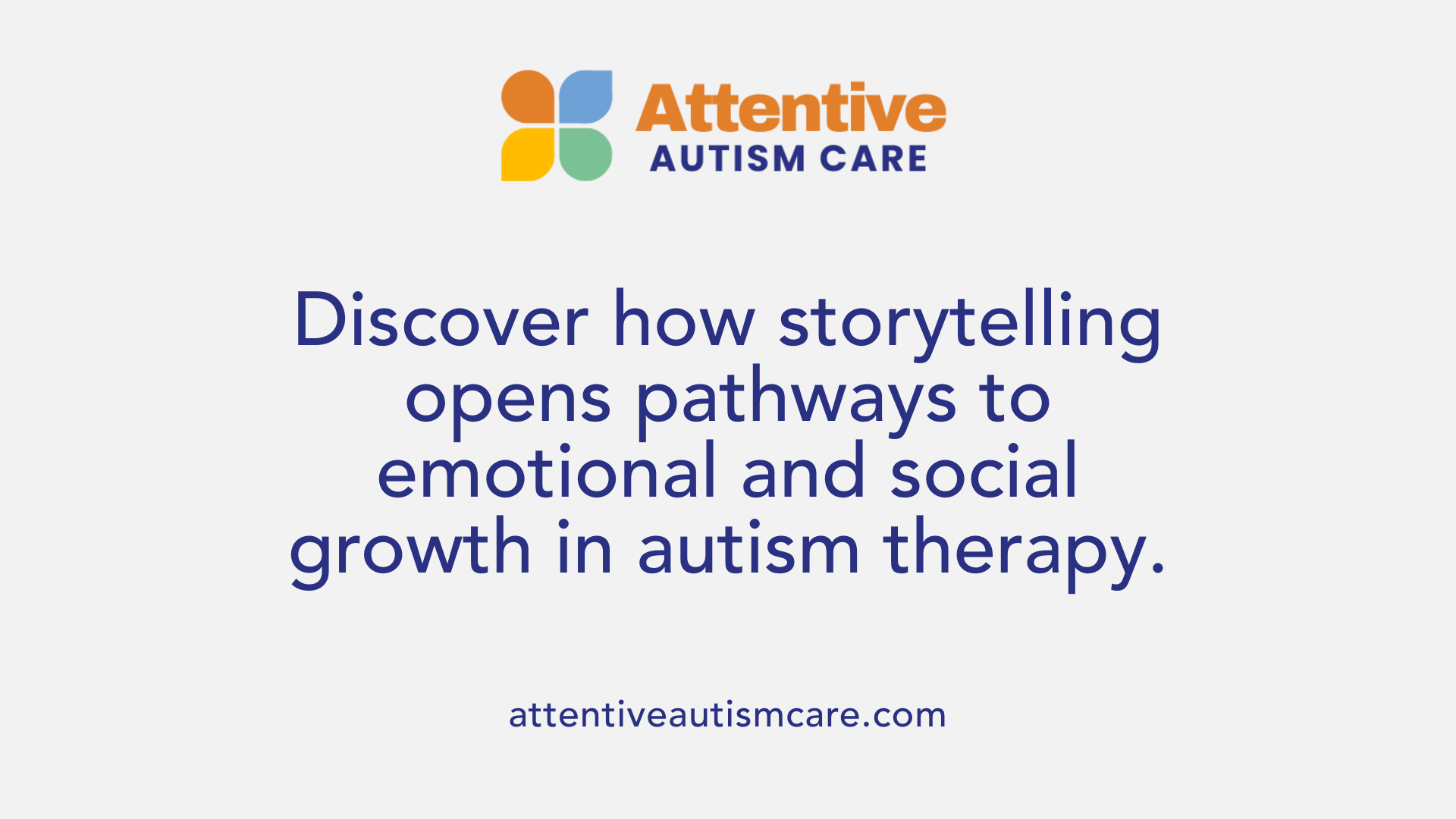
How is storytelling used in therapy for individuals with autism?
Storytelling has become a vital part of therapeutic strategies for individuals with autism. Its roots trace back to the early 1990s when social stories were developed by Carol Gray to help children with autism understand social cues and norms. These stories are tailored narratives that depict social situations like visiting the doctor or making friends, simplifying complex social skills into manageable and understandable segments.
In therapy, storytelling helps children express their thoughts, feelings, and experiences in a safe and structured manner. Through personal stories, visual storytelling, or even filmmaking, individuals are encouraged to share their perspectives, which fosters self-awareness and emotional regulation. Using props, costumes, and visual aids, therapists can make stories more engaging and accessible, particularly for children with sensory sensitivities.
Moreover, storytelling allows children to rehearse real-life scenarios and social interactions in a controlled environment. For example, social stories designed specifically for certain situations—such as transitioning between activities or handling disagreements—help children anticipate what to expect and how to respond appropriately.
Research supports that storytelling can significantly improve social interaction skills, attention span, and emotional understanding. For children with severe cognitive impairments and ASD, role-playing and narrative exercises have shown to increase eye contact, reduce problematic behaviors, and promote social engagement.
Overall, storytelling acts as both a therapeutic and educational tool, breaking down social norms into understandable narratives, thereby building confidence, communication skills, and emotional intelligence.
Narrative as a medium for emotional expression
Narratives serve as a bridge for emotional expression among autistic individuals. Many use storytelling to articulate feelings they might find difficult to express directly. Personal stories and visual narratives help individuals process their emotions and share their experiences without feeling overwhelmed.
Visual storytelling tools, such as pictures, symbols, or videos, are especially effective—they make abstract feelings more concrete. Techniques like character development and the use of multisensory elements deepen emotional understanding and foster empathy. For instance, characters in stories modeling real-life situations enable comfort and learning in a non-pressuring way.
Storytelling also provides a chance for individuals to rehearse social responses and develop emotional literacy in a predictable context. This process enhances self-esteem and helps in creating a positive sense of identity, ultimately supporting social integration and emotional well-being.
Therapeutic benefits of storytelling techniques
Various storytelling strategies have demonstrated therapeutic benefits. Social stories, in particular, help children navigate routine social situations, reducing anxiety and improving behavior. Developed by trained professionals and often using visual aids, these stories are personalized to fit individual needs.
Interactive storytelling, which involves active participation such as repeating phrases or acting out scenes, enhances engagement and attentiveness. Repetition and explicit instructions teach children to pay attention to subtle cues like facial expressions and tone of voice.
Digital tools, such as apps like BASICS, incorporate interactive and story-based learning to bolster speech, emotional, and social development. They use stories with relatable characters and structured tasks to progress through developmental milestones, from vocabulary building to emotional regulation.
Research indicates that engaging in storytelling—especially when combined with role-playing and peer interaction—produces significant improvements in social skills, communication, and emotional awareness. It fosters self-confidence and provides a safe space for practicing social norms, paving the way for better integration into everyday social environments.
The Benefits and Effectiveness of Storytelling in Autism Treatment
What benefits does storytelling offer as a therapy for autism?
Storytelling presents a wide array of advantages for individuals with autism. It significantly improves language and communication skills, helping children expand their vocabulary, develop better listening abilities, and grasp complex social cues. Through storytelling, children learn to interpret facial expressions, tone of voice, and body language, which are often challenging for those on the spectrum.
The process enhances social understanding and empathy by framing social norms and interactions within relatable narratives. By engaging with stories that depict everyday situations, children can rehearse responses, reduce anxiety, and increase confidence in social settings.
Creativity and emotional resilience are nurtured as children explore themes like emotional growth, problem-solving, and redemption through stories. Using props, costumes, visual aids, and interactive participation makes storytelling more immersive, fostering emotional recognition and connection.
Research supports the effectiveness of storytelling therapy. For example, studies involving children with severe cognitive impairments show marked improvements in social interaction, such as increased eye contact and imitation. Visual storytelling tools like social stories, developed by Carol Gray, help children understand social norms and routines, reducing behavioral issues and promoting adaptive skills.
Moreover, technology-enhanced storytelling, including apps and interactive videos, extends the reach and engagement of therapy. These tools tailor narratives to individual needs, promoting consistent practice and gradual mastery of social and language skills.
In summary, storytelling is not only a therapeutic tool for teaching language and social norms but also a means of emotional growth and confidence building. Its adaptability and evidence-based benefits make it a valuable component of autism supportive interventions.
Social Stories: A Structured Approach to Developing Social Skills
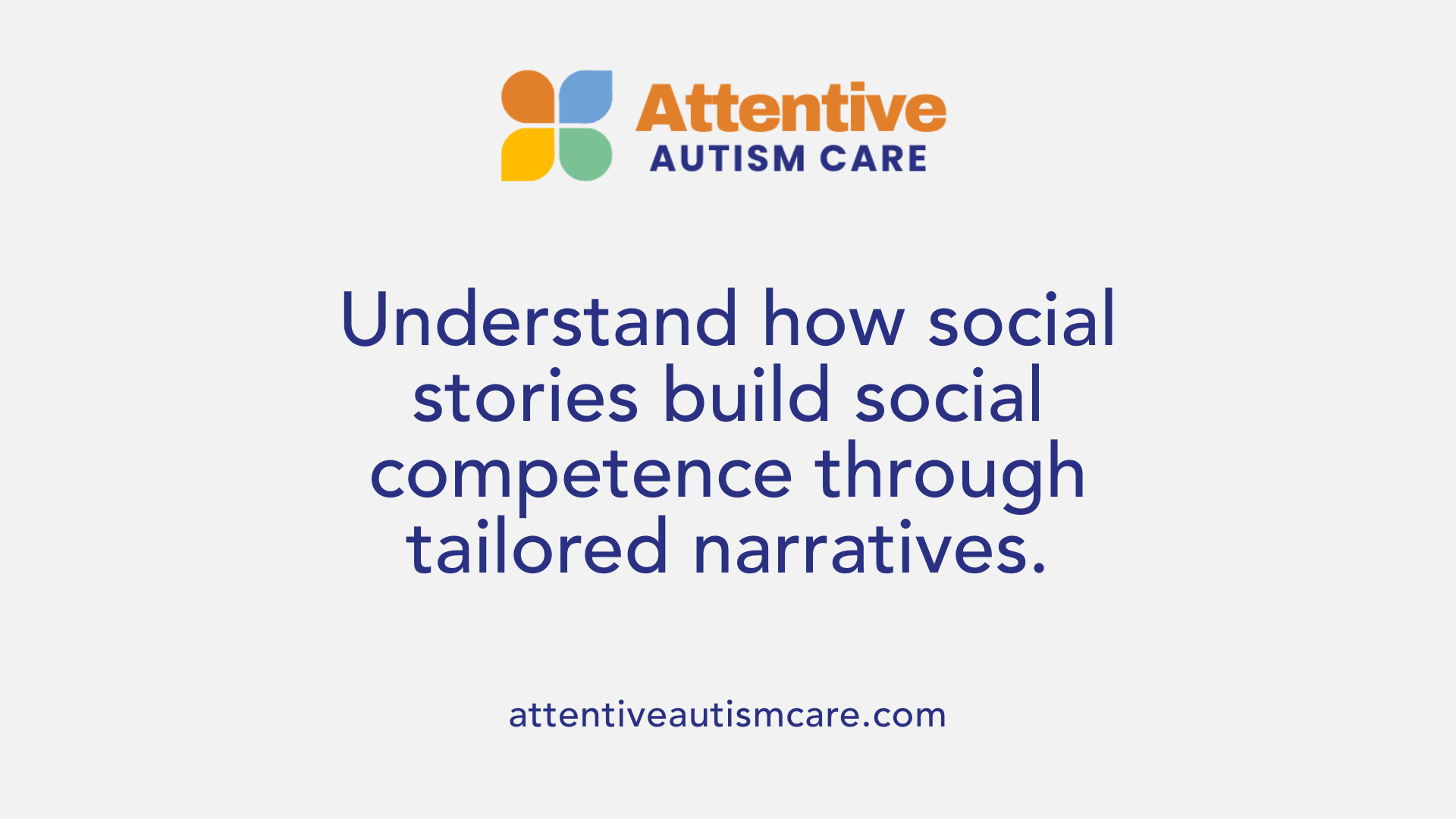
What are social stories and why are they used?
Social stories are specially crafted narratives that help children with autism understand and navigate social situations. Created to clarify social norms and expectations, these stories are a valuable tool in supporting social skill development. Developed in 1991 by educator Carol Gray, social stories aim to reduce anxiety, improve social understanding, and promote appropriate behaviors.
What components and structure do social stories have?
A typical social story includes multiple elements designed to make the information clear and accessible. It often contains:
| Element | Purpose | Example |
|---|---|---|
| Perspective | Explains others' feelings and viewpoints | "When I see my friend crying, I know she might be upset." |
| Descriptive | Details the social situation | "At the supermarket, I wait my turn in line." |
| Directive | Suggests what the child can do | "I can use my words to ask for help if I am lost." |
| Affirmative | Positively reinforces expected behaviors | "I feel proud when I share my toys." |
| Visuals | Photos or drawings to support understanding | Pictures of a handshake or a waiting line |
These stories are written using simple language suited to a child's age, often including illustrations or photos to support comprehension.
How do social stories help children understand social norms?
Social stories clarify what is expected in various social contexts, such as visiting a new place or interacting with peers. By breaking down complex situations into manageable parts, children learn appropriate responses and behaviors.
They explicitly address common challenges faced by children with autism, such as understanding personal space, turn-taking, or recognizing emotions through facial expressions.
Research shows that reading social stories before encountering a social situation prepares children to respond appropriately, reducing anxiety and increasing confidence.
Supporting Social Skill Development
Social stories promote social skill growth by:
- Teaching recognition of nonverbal cues like facial expressions and body language.
- Reinforcing positive behaviors through repeated practice.
- Facilitating conversations by modeling language and social exchanges.
- Providing a safe space to rehearse real-world interactions.
Practical application of social stories
They can be used at home, in schools, or therapy sessions. For example, a social story about going to the doctor might include pictures of the clinic and phrases describing what will happen, helping the child feel more prepared.
Professionals and parents often personalize social stories, tailoring content to individual needs and specific situations. Reading these stories just before the event enhances understanding and readiness.
Positive effects of social stories
Studies involving children with autism show improvements in social interaction, communication, and behavior when social stories are used consistently. They help children understand social cues, develop empathy, and participate more fully in social settings.
Research indicates that social stories are a low-cost, caregiver-friendly, and effective intervention, with evidence supporting their role in fostering social competence among children with autism.
Techniques and Methods of Storytelling in Autism Therapy
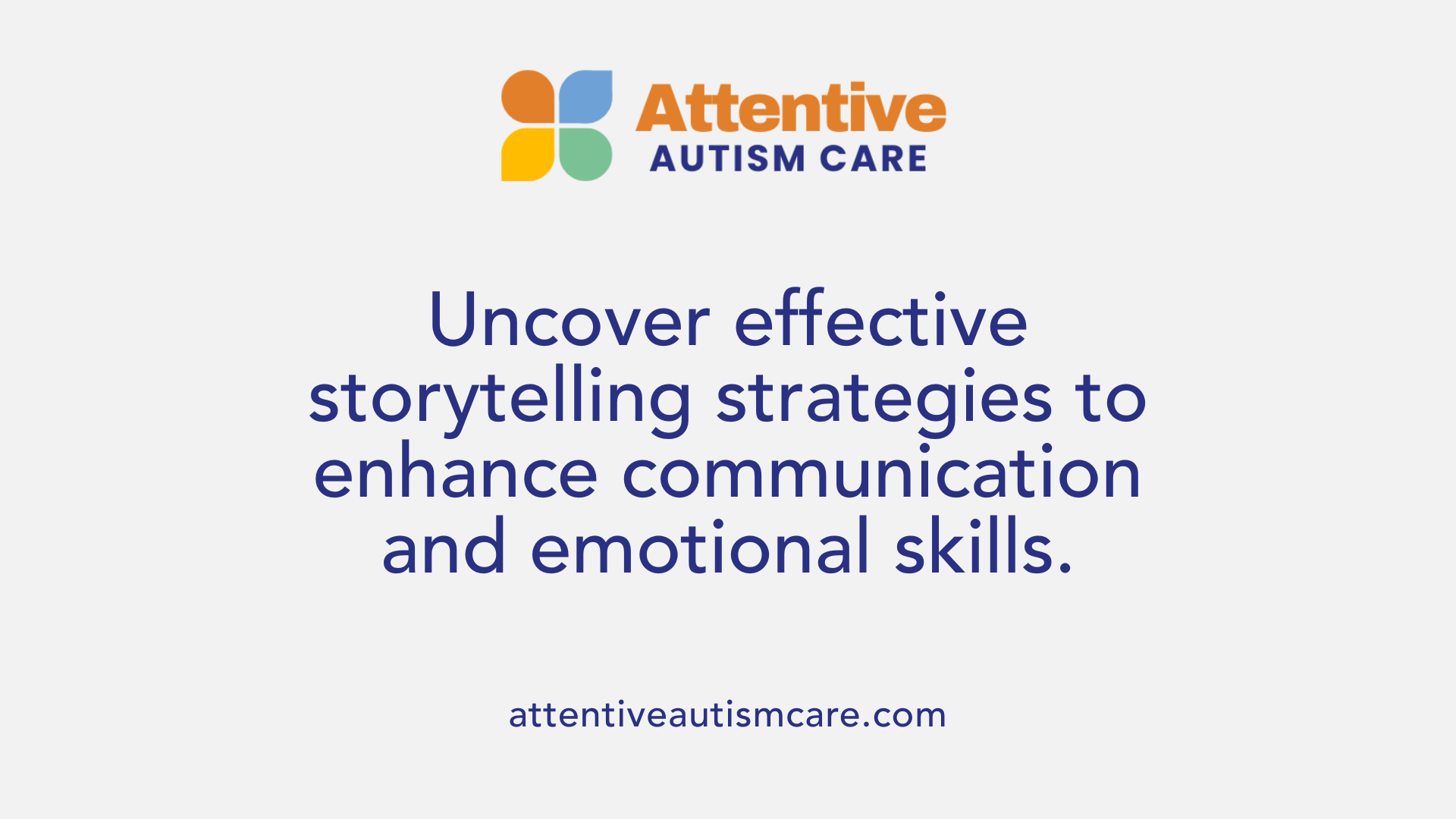
What are effective methods and techniques of storytelling in autism therapy?
In autism therapy, storytelling employs various methods designed to improve communication, social skills, and emotional understanding. Visual supports are fundamental; these include pictures, symbols, and videos, which help children better comprehend stories and stay engaged. Personal and social stories, often created in collaboration with therapists, are tailored to address individual needs. They teach children about social cues, emotional regulation, and everyday routines, reducing anxiety and building confidence.
Bringing stories to life involves the use of gestures, facial expressions, vocal tones, and body movements. These elements serve as visual cues that help children interpret emotions and reactions, which can be challenging for them. Repetition of phrases and active participation, such as acting out parts of the story, reinforce learning and strengthen attention spans.
Interactive activities play a crucial role. Role-playing and improvisation allow children to practice social scenarios in a safe, controlled environment. Props and costumes further enhance this engagement, providing tactile and visual stimulation that makes stories more immersive.
Technology also offers innovative tools for storytelling. Digital apps and communication devices incorporate interactive features, stories with animations, and customizable content. These tools can adapt to a child’s developmental level, making learning personalized and more effective.
In summary, combining visual, auditory, tactile, and technological techniques creates a rich, multisensory storytelling experience. Such approaches not only improve linguistic and social skills among children with autism but also foster emotional growth and social connectivity.
Research Supporting Storytelling Interventions in Autism
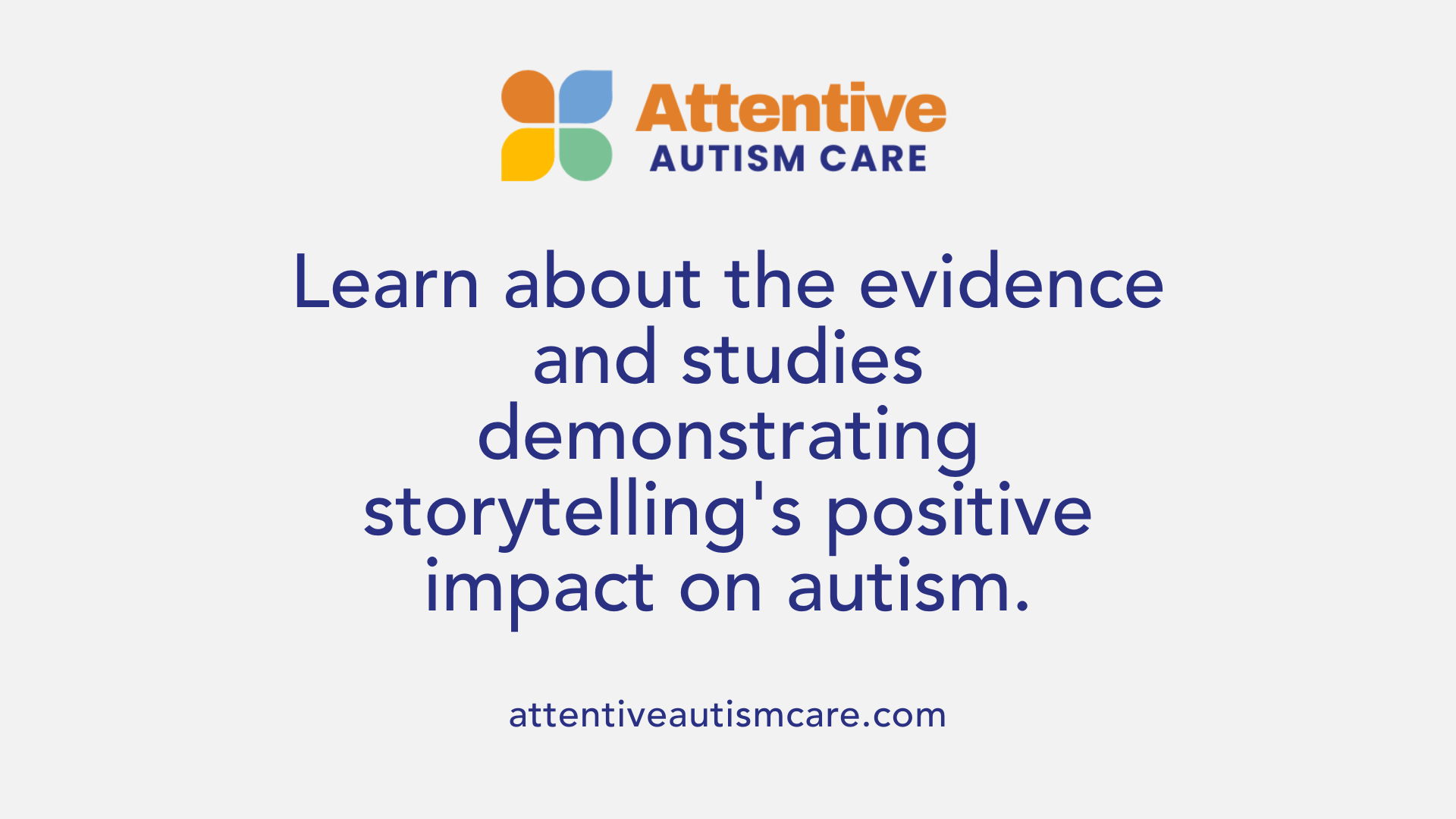
What research supports the use of storytelling therapy for autism?
Numerous studies and reviews highlight the positive impact of storytelling and social stories as effective tools for supporting individuals with autism spectrum disorder (ASD). Social stories, a structured form of storytelling, are widely used to teach social norms, improve communication, and reduce anxiety among children with autism.
Research findings show that social stories, especially when personalized and developed with input from therapists or caregivers, can lead to significant improvements in social interaction, emotional understanding, and behavior. For example, a 2015 study involving 30 children with autism demonstrated that social story training enhanced their ability to engage socially and better interpret cues.
Large-scale reviews and meta-analyses support these observations. The National Standards Project classifies social stories as an evidence-based intervention for children with autism, particularly effective in increasing social skills and managing problematic behaviors.
However, the evidence base has some limitations. Many studies suffer from small sample sizes, lack of control conditions, or variations in how the stories are implemented. Despite this, consistent positive outcomes have encouraged widespread use, especially when stories are tailored to individual needs and combined with other therapies.
Furthermore, innovative digital tools like the SOFA app utilize storytelling-based learning, combining visual, auditory, and interactive elements. These applications promote language development, emotional recognition, and social skills, especially in young children.
In summary, while more rigorous research is needed, current evidence strongly supports storytelling interventions as a valuable component of autism therapy, particularly when individualized and integrated into a broader treatment program.
Strategies for Implementing Storytelling Interventions in Autism Therapy
How can practitioners implement storytelling-based interventions in autism therapy?
Practitioners can successfully use storytelling techniques by adopting structured and personalized approaches such as Social Stories, developed by Carol Gray in 1991. These stories follow specific guidelines, including using simple language, visual supports, and clear explanations of social norms.
The process involves reading the stories aloud or silently with the child, followed by comprehension questions to reinforce understanding. Role-playing activities based on the stories help children practice skills like sharing, taking turns, and managing emotions in real-life situations.
Effective storytelling interventions are tailored to each child's needs, focusing on relevant behaviors or anxieties, such as transitions or social interactions. Visual aids like pictographs, graphic organizers, or photos support comprehension, especially for children with autism who have difficulty interpreting nonverbal cues.
In addition to traditional methods, digital tools and applications available on tablets or computers facilitate engaging, personalized Social Stories. For instance, apps like BASICS incorporate animated adventures that help children recognize and regulate emotions, practice speech skills, and improve social understanding.
Research highlights that incorporating storytelling in therapy can lead to positive improvements in social behaviors, emotional recognition, and anxiety management, with effects often lasting over time. Clinicians may also employ narrative interventions to teach story grammar, inferencing, and complex language skills by encouraging children to retell stories or create their own.
Active participation from children, involvement of caregivers, and planning for generalization across settings—home, school, and community—are essential. When storytelling activities are integrated into daily routines, children are more likely to transfer learned skills to various environments, promoting independence and social competence.
Implementing storytelling strategies with consistency and customization provides a powerful tool for fostering communication, emotional understanding, and social growth in children with autism, making it an invaluable component of comprehensive therapy plans.
Conclusion: The Future of Storytelling in Autism Therapy
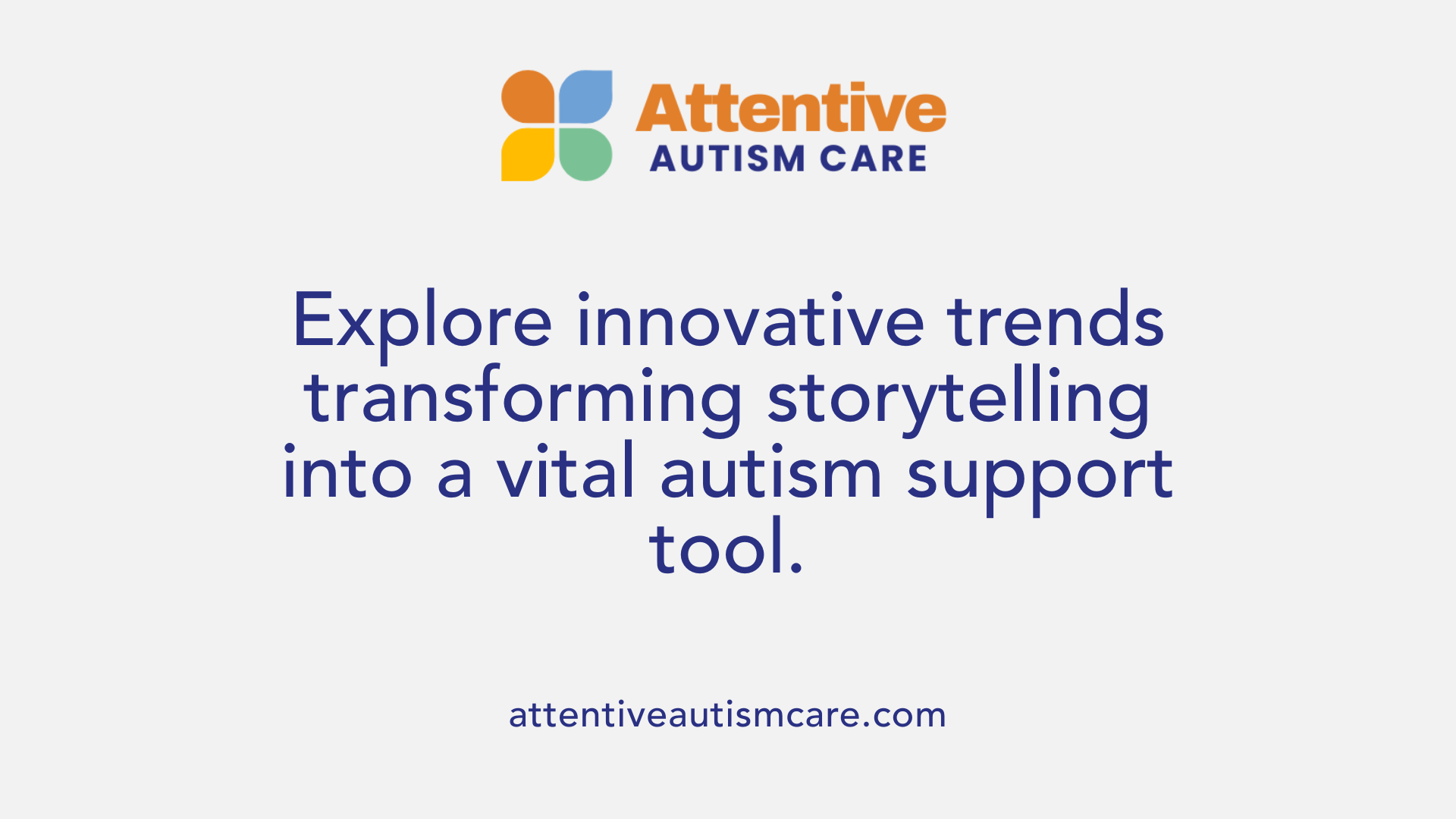 Emerging trends and technologies are poised to transform how storytelling is used in autism therapy. Innovative tools such as artificial intelligence-driven apps, virtual reality, and multisensory storytelling environments are making stories more engaging and customizable. These advances allow individuals on the autism spectrum to experience stories in ways that align with their sensory preferences and learning needs.
Emerging trends and technologies are poised to transform how storytelling is used in autism therapy. Innovative tools such as artificial intelligence-driven apps, virtual reality, and multisensory storytelling environments are making stories more engaging and customizable. These advances allow individuals on the autism spectrum to experience stories in ways that align with their sensory preferences and learning needs.
Integration with other therapeutic modalities is also on the rise. Combining storytelling with approaches like social skills training, cognitive-behavioral therapy, and executive functioning interventions can create more comprehensive support plans. Such integration helps reinforce skills like emotional regulation, empathy, and social understanding, making storytelling a versatile component within broader therapy frameworks.
Despite promising developments, there remains a need for further research to establish evidence-based practices and measure long-term outcomes. Studies exploring how storytelling influences social perception, emotional growth, and communication in diverse age groups will guide future applications. Continued research will help refine strategies, making therapeutic storytelling more effective and accessible.
Encouraging inclusive storytelling practices is essential for promoting neurodiversity and ensuring that all individuals feel represented and understood. This includes developing stories that reflect varied perspectives, sensory needs, and cultural backgrounds. Inclusive storytelling fosters a sense of belonging and supports the development of social and emotional skills across the autism spectrum.
As awareness and technological innovations advance, the future outlook for storytelling as a therapy tool for autism remains optimistic. Its potential to facilitate connection, understanding, and self-expression can significantly improve lives. Embracing these trends and fostering inclusive practices will help maximize storytelling’s positive impact in autism support and education.
Summary and Final Thoughts
Storytelling serves as a powerful tool in autism interventions by facilitating social understanding, emotional expression, and communication skills development. Whether through personal narratives, social stories, visual aids, or digital apps like BASICS, storytelling helps children and adults with autism interpret social cues, rehearse real-life situations, and foster self-awareness.
Practitioners and caregivers can utilize storytelling effectively by customizing approaches that match the individual’s needs. Incorporating visual supports, props, costumes, and multisensory elements makes stories more engaging and accessible. Repetition of stories and explicit instructions—such as paying attention to facial expressions or tone of voice—can significantly improve comprehension and response.
Empowering children through participation—whether by repeating phrases, acting out parts, or discussing characters’ feelings—enhances social and emotional skills. The development of social stories tailored to specific situations, like visiting the doctor or making friends, can reduce anxiety and promote positive behavior.
A personalized, multimodal approach ensures that storytelling meets diverse needs. Collaboration among professionals, caregivers, and the individual creates relevant, meaningful narratives that reinforce learning and confidence.
While current research underscores storytelling’s benefits, continuous innovation driven by ongoing studies will further expand its potential. Exploring new technologies and interactive methods can make storytelling an even more effective part of inclusive autism support.
In summary, embracing storytelling’s versatility offers a gentle yet impactful way to support growth, empathy, and independence for autistic individuals. Patience, creativity, and personalization remain essential as practitioners and caregivers work together to unlock the full potential of storytelling-based interventions.
Embracing Narrative: Charting a Path Forward in Autism Care
Storytelling is a powerful, multifaceted tool that offers therapeutic, developmental, and advocacy benefits for individuals with autism. When carefully tailored and thoughtfully implemented, it can bridge communication gaps, foster social understanding, and nurture emotional resilience. As technology advances and evidence accumulates, the potential for storytelling to transform autism therapy continues to grow. Practitioners, caregivers, and researchers must work together to harness this narrative power, ensuring that storytelling remains an inclusive, effective, and enriching approach in autism care.
References
- Using Storytelling as a Self-Advocacy Tool - Autism Spectrum News
- Important Ways Storytelling Can Benefit Kids with Autism
- Storytelling as a Tool for Autistic Communication - Silver Swing ABA
- Social stories and autism | Raising Children Network
- Autism And Teaching Narratives | Speech Therapy CEUs
- Social Stories for Autistic Children – The Ultimate Guide
- BASICS – A Story Based Speech and Autism App for Kids
- New Study On the Power of Storytelling for Autism Spectrum Disorder




































































































